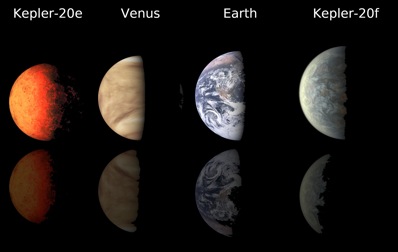
First “mini-Earth” discovered around Sun-like star
DR EMILY BALDWIN
ASTRONOMY NOW
Posted: 21 December 2011


A rocky exoplanet smaller than Earth, and its neighbouring Earth-sized world with a thick water-vapour atmosphere, have been detected around a Sun-like star already known to host three larger planets.
The planets were detected by NASA's Kepler spacecraft, which watches for tiny dips in brightness of thousands of stars as a planet transits in front of them, temporarily blocking out a miniscule fraction of their light. One of the new planets identified around 1,000 light year distant Kepler-20 – Kepler-20f – has a radius almost identical to Earth at 1.03 Earth radii, and the other is just 0.87 Earth radii – smaller also than planet Venus – and is the smallest exoplanet ever identified around a Sun-like star.

The first detected “mini-Earth” and an Earth-sized planet with a water-vapour atmosphere are two of five planets found orbiting Kepler-20. Image: NASA/Ames/JPL-Caltech.
“We were able to detect a periodic decrease in starlight smaller than 0.01 percent that occurred every six days for Kepler-20e, and another periodic decrease that occurred every 20 days, for around two years. From these signals, we could determine the planet sizes, and their orbital distance,” explains François Fressin of the Harvard Smithsonian Center for Astrophysics, and lead author of a Nature paper announced today. “Their masses are so small that we have not yet been able to measure them through the gravitational pull that the planets exert on their parent star, but we can very reasonably assume that both Earth-size objects are rocky.”
Fressin and colleagues report that the planets are not only Earth-like in size but also in composition, with an iron core and silicate mantle. Furthermore, Kepler-20f may have developed a thick water-vapour atmosphere. But with Kepler-20e orbiting at just 7.6 million kilometres and Kepler-20f at 16.5 million kilometres from their star, this places them between 10 and 20 times closer to Kepler-20 than Earth orbits the Sun, invoking temperatures of at least 600 hundred degrees Celsius on their surfaces.
Despite the sweltering environment, the authors speculate that Kepler-20f could still host a water-vapour atmosphere if it had formed beyond the snow line – the location in a solar system beyond which solid ice is stable – and then migrated inwards. Its watery reservoir could be maintained for several billion years at its current location and the thick atmosphere would protect the planet’s surface from the intense solar radiation. Any atmosphere that Kepler-20e may have once had, however, has long since gone.
Identifying such small planets is not easy, and Fressin et al had to be able to rule out other possibilities for the observed signals, such as an unseen star eclipsing the star Kepler was observing, or a brown dwarf orbiting the sun.
“We did a large scale simulation of astrophysical configurations that could mimic the transit signals, and were able to rule out the huge majority of those as potential causes for the signals we see because they could not either match the Kepler data, or the observational constraints from other telescopic observations,” Fressin tells Astronomy Now. “These two planets are confirmed. The signals could not be due to anything else except Earth-size planets.”
The other planets in the system, Kepler-20b, c and d, are all larger than Earth, with radii of 1.91, 3.07 and 2.75 times that of Earth, and orbit their sun with periods of 3.7, 10.9 and 77.6 days respectively.
Finding a planet smaller than Earth, as well as a planet almost identical in size, is an important step in the search for the ultimate prize of an Earth-like world orbiting a star in its habitable zone – a distance where liquid water is stable.
|



